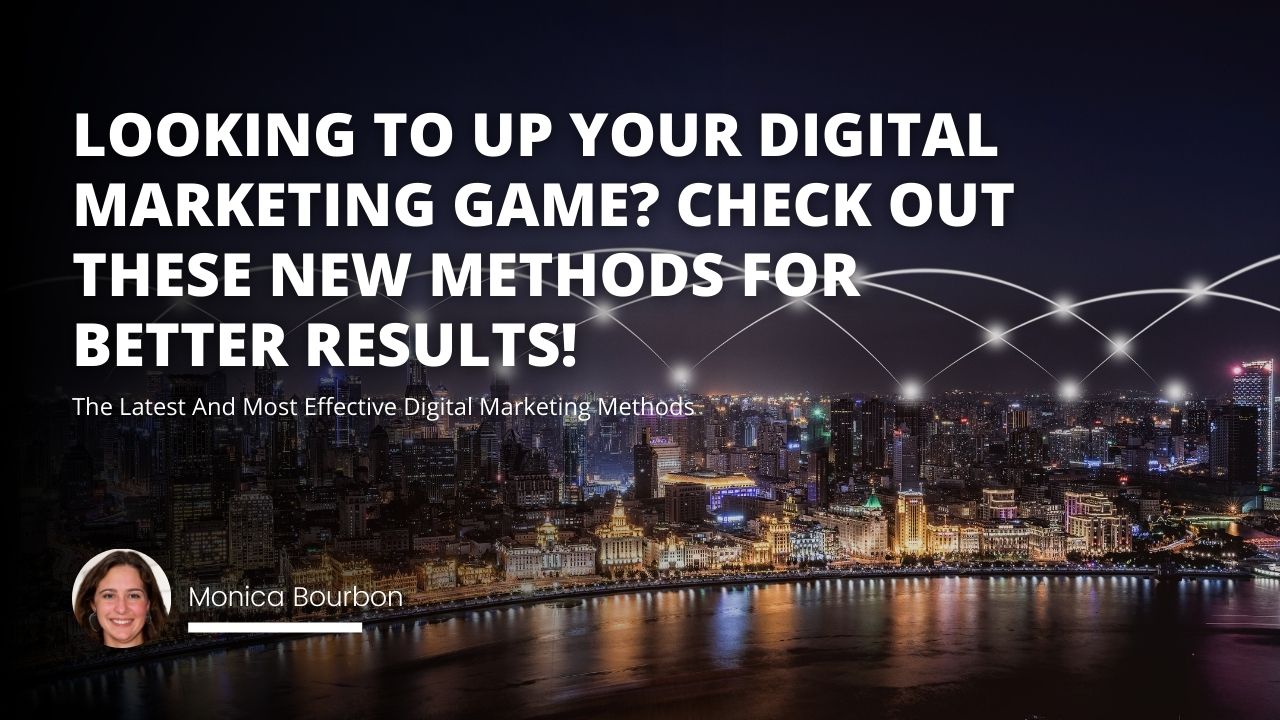
It’s no secret that the digital age has drastically changed the way businesses operate. While traditional marketing methods are still important, digital marketing has become a key component of most successful marketing plans. This blog post will explore the differences between conventional and digital marketing and discuss why you should consider incorporating digital marketing into your business plan. Stay tuned!
Related Course: Digital Marketing Free Course
The most significant difference between traditional marketing and digital marketing is how consumers access information. Traditional marketing was focused on print ads, billboards, and television commercials in the past. These methods allowed businesses to reach a broad audience, but they were also costly. In addition, traditional marketing techniques did not allow for much interaction or engagement with potential customers.
Digital marketing, on the other hand, is focused on online platforms such as social media, websites, and email. This type of marketing is much less expensive than traditional marketing. It allows businesses to interact directly with potential customers. Additionally, digital marketing provides enterprises with valuable data and insights about their target audience.
Another critical difference between traditional marketing and digital marketing is how each type of marketing is measured. Traditional marketing efforts are often difficult to measure because they rely on brand awareness or sales figures. Digital marketing, however, can be easily tracked and measured using analytics tools. This data can then be used to improve future marketing campaigns.
So, why should you consider incorporating digital marketing into your business plan? Digital marketing is a powerful tool that can help you reach your target audience, interact with potential customers, and track your marketing efforts. Additionally, digital marketing is much less expensive than traditional marketing, making it an excellent option for small businesses. If you do not already know digital marketing and the differences between traditional marketing, now is the time to learn in this blog!

What is Traditional Marketing?
Traditional marketing uses promotional techniques to reach out to customers and generate interest in a product or service. It typically involves activities like advertising, public relations, and direct marketing.
What are traditional marketing channels?
Traditional marketing aims to create awareness about a brand or product and persuade customers to purchase it. Businesses use various channels to reach their target audience, including television, radio, print, and digital media.
Evaluating the effectiveness of traditional marketing
Traditional marketing can be very effective in promoting products and services and generating sales. However, it can also be quite expensive, especially for small businesses. Additionally, it can be challenging to measure the results of traditional marketing campaigns.
Despite these challenges, traditional marketing remains an essential part of many businesses marketing strategies. It can be beneficial for companies just starting out and need to create a lot of awareness about their brand quickly. In addition, traditional marketing can complement other marketing efforts, such as digital marketing.
The future of traditional marketing
Looking to the future, it’s likely that traditional marketing will continue to play a role in business. However, the exact nature of that role is yet to be determined. As technology evolves and new channels emerge, traditional marketing will likely need to adapt to stay relevant. But, given its long history and proven effectiveness, there’s an excellent chance to remain an essential part of the marketing mix for years to come.

What is Digital Marketing?
Digital marketing is the process of using electronic channels to promote or market products and services. Common examples of digital marketing channels include email, social media, search engine optimization (SEO), and pay-per-click (PPC) advertising.
What are digital marketing objectives?
Digital marketing objectives usually fall into three categories: awareness, conversion, or engagement. Awareness objectives focus on getting people to learn about a brand or product. Conversion objectives concentrate on getting people to take the desired action, such as making a purchase. Finally, engagement objectives focus on getting people to interact with a brand or product in some way, such as leaving a positive review.
What are some of the most common digital marketing channels used today?
Email is often seen as one of the most effective digital marketing channels because it allows businesses to directly contact their target audience. However, email can also be one of the most challenging channels to master due to its ever-changing algorithms and spam filters.
Social media is another popular digital marketing channel that can be highly effective when used correctly. However, businesses must be careful not to overdo it with their social media presence or risk coming across as spammy or inauthentic.
Search engine optimization (SEO) is a digital marketing strategy that improves a website’s visibility in search engine results pages (SERPs). By optimizing their website for specific keywords, businesses can attract more qualified leads to their site. However, SEO takes time and effort to master and keep up with the latest algorithm changes.
Pay-per-click (PPC) advertising is a digital marketing channel that allows businesses to pay for ads on SERPs. PPC can be an effective way to drive traffic to a website, but it can also be expensive if not managed properly.
When used correctly, digital marketing channels can be highly effective in promoting and selling products or services online. However, it’s essential to understand the pros and cons of each channel before investing too much time or money into any one particular strategy.
What are the benefits of using digital marketing for businesses?
Digital marketing is a critical component of modern business strategy. By utilizing digital channels, businesses can connect with customers with who they are already spending time online. This helps companies to reach a larger audience and promotes brand awareness. Additionally, digital marketing can target specific customers with personalized messages, increasing the likelihood of conversion.
Digital marketing is an essential part of any business’s marketing mix. By incorporating digital marketing into your overall marketing strategy, you can reach a larger audience and achieve your business goals.
Similarities between traditional and digital marketing
There are a few key similarities between traditional and digital marketing. First, both types of marketing rely heavily on audience research and segmentation to be effective. Additionally, both involve using various channels to reach consumers, including television, radio, print, and online.
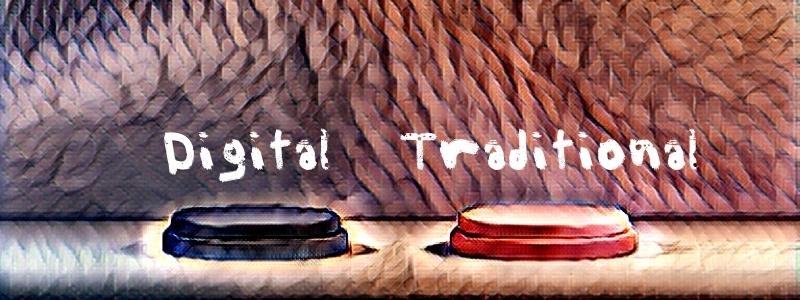
Traditional Marketing vs. Digital Marketing
One of the most significant differences between traditional and digital marketing is how consumers receive information. Consumers typically receive information through one-way channels like television or print ads with traditional marketing. However, with digital marketing, consumers can seek out information themselves through two-way channels like social media or search engines. This allows for a more interactive and engaging experience for the consumer.
Digital marketing also offers some advantages over traditional marketing when measuring results. For example, businesses can track data like website traffic, sales conversions, and click-through rates with digital marketing. This information can adjust campaigns and strategies in real-time, making digital marketing a more flexible and responsive tool. Additionally, digital marketing is often less expensive than traditional marketing methods, making it a more viable option for small businesses and startups.
In the end, both traditional and digital marketing have their own strengths and weaknesses. By understanding these differences, businesses can create a more well-rounded marketing strategy that combines the best of both worlds.
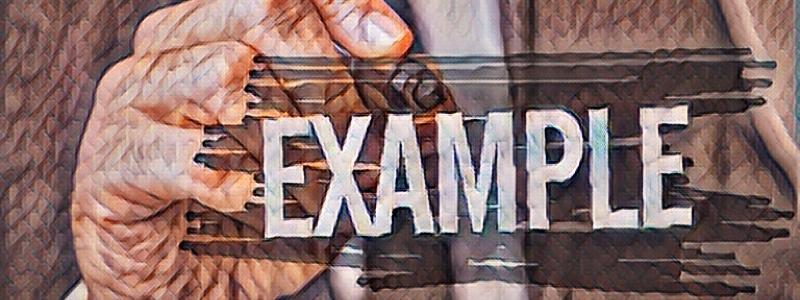
Examples of Traditional and Digital marketing
Traditional marketing refers to any type of marketing done through offline channels, such as print, TV, radio, and direct mail. Digital marketing, on the other hand, refers to any type of marketing that is done online through channels such as search engines, social media, email, and websites.
Examples of Traditional Marketing
Traditional marketing includes print advertising, radio and television, and direct mail.
Print advertising
Print advertising can be in newspapers, magazines, or billboards.
Radio and television advertising
Radio and television advertising is another form of traditional marketing that uses audio or visual messages to promote a product or service.
Direct mail
Direct mail is a type of marketing that involves sending physical materials like postcards or flyers to potential customers.
Examples of Digital marketing
Marketing isn’t just about billboards and TV ads in the digital age. If you want to reach your target audience, you need to be where they are: online. That’s where digital marketing comes in.
Digital marketing is an umbrella term that covers a variety of marketing activities. Here are some examples:
Website design and development
Your website is often the first impression potential customers will have of your business, so it’s essential to make sure it’s designed and developed with your target market in mind. A good website will be user-friendly, visually appealing, and informative, providing visitors with everything they need to know about your products or services.
Search engine optimization (SEO)
SEO is about improving your website’s visibility on search engine results pages. By optimizing your site for relevant keywords and phrases, you can attract more visitors looking for what you have to offer.
Social media marketing
Social media is a powerful platform for connecting with potential and current customers. By regularly posting engaging content, you can build relationships, drive traffic to your website, and generate leads and sales.
Content marketing
Content is a great way to educate your audience about your products or services and build trust and credibility. By creating helpful, informative blog posts, articles, eBooks, and infographics, you can reach your target market and establish yourself as an expert in your field.
Pay-per-click (PPC) advertising
PPC is a form of online advertising that allows you to pay for placement on search engine results pages. By bidding on relevant keywords, you can reach potential customers actively searching for what you have to offer.
Digital marketing is a necessary part of doing business in the modern world. By using these various marketing strategies, you can reach your target audience where they are and promote your products or services effectively.
Although the digital age has brought about many changes, including how we market our products and services, one thing remains unchanged- the need for a well-executed marketing strategy. Whether your business is just starting out or looking to revamp your current plan, it’s essential to understand the differences between traditional and digital marketing. Our digital marketing course can help you create a winning strategy to reach more customers and increase ROI. So join us today to get started!
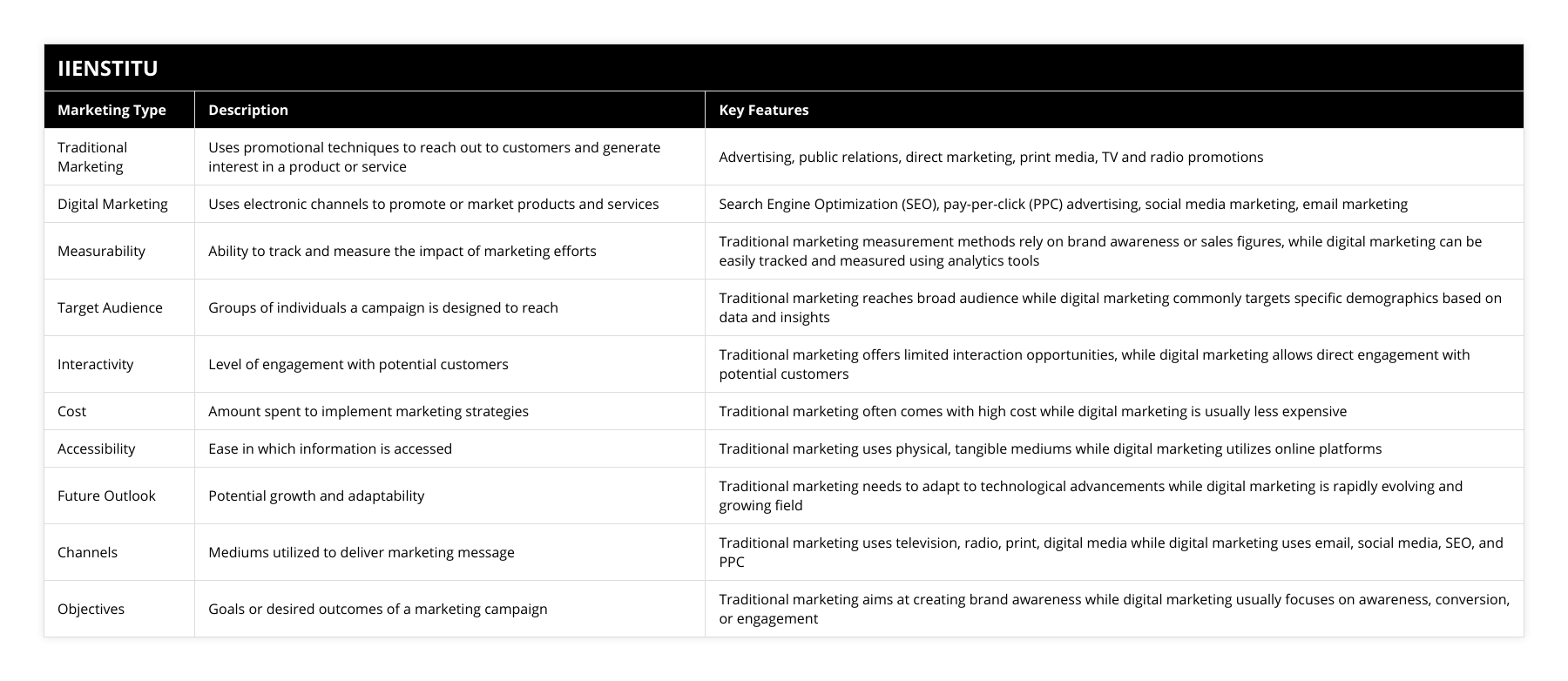
Frequently Asked Questions
What is traditional marketing?
Traditional marketing is a type of advertising that uses paid media to reach potential customers. It typically involves TV, radio, print, or digital ads to promote a product or service.
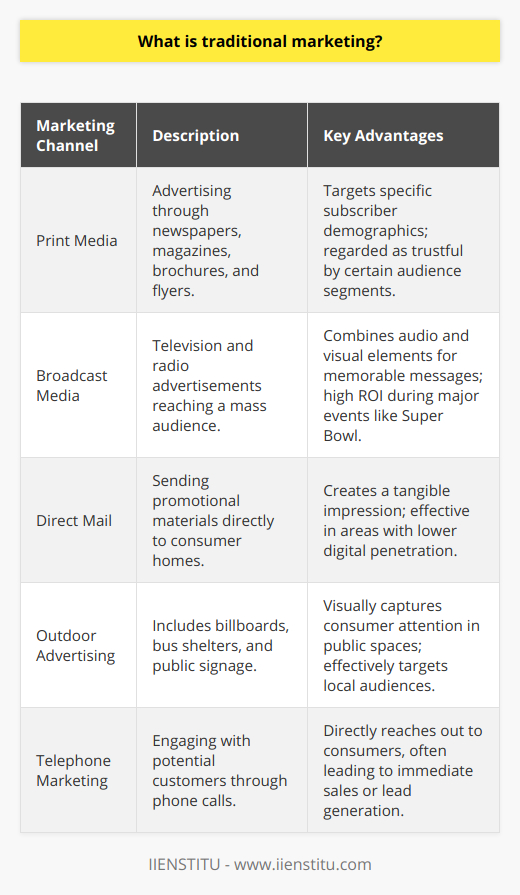
What is digital marketing?
Digital marketing is the process of marketing your products or services online. This can include creating a website, writing blog posts, using social media to promote your business, and much more. Basically, anything you can do to market your business online is considered digital marketing.
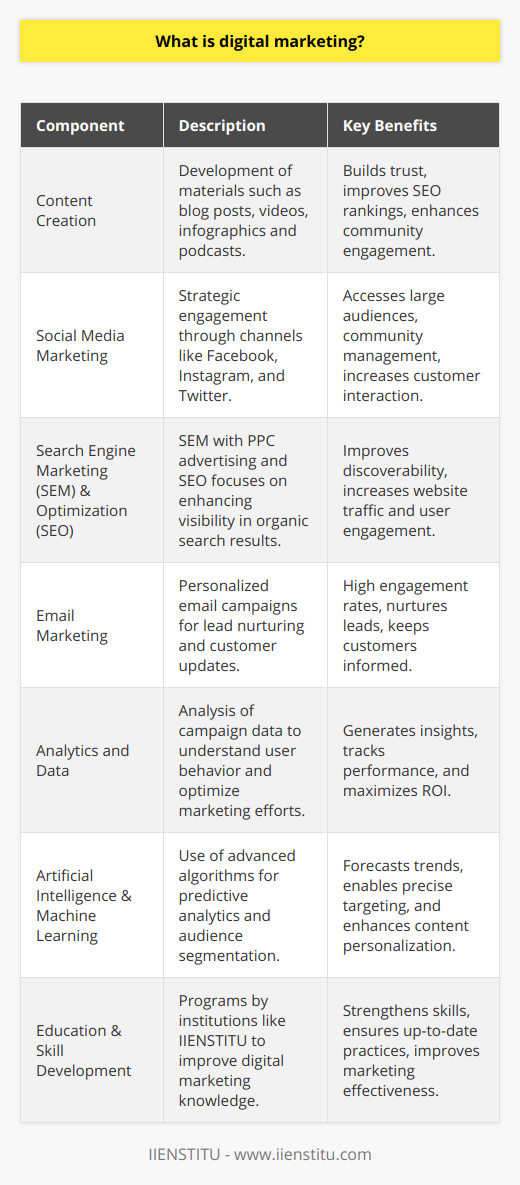
What are the key differences between traditional and digital marketing?
The critical difference between traditional and digital marketing is that traditional marketing is more about reaching many people through channels like TV, radio, or print. In contrast, digital marketing targets specific people through channels like websites, social media, or email.
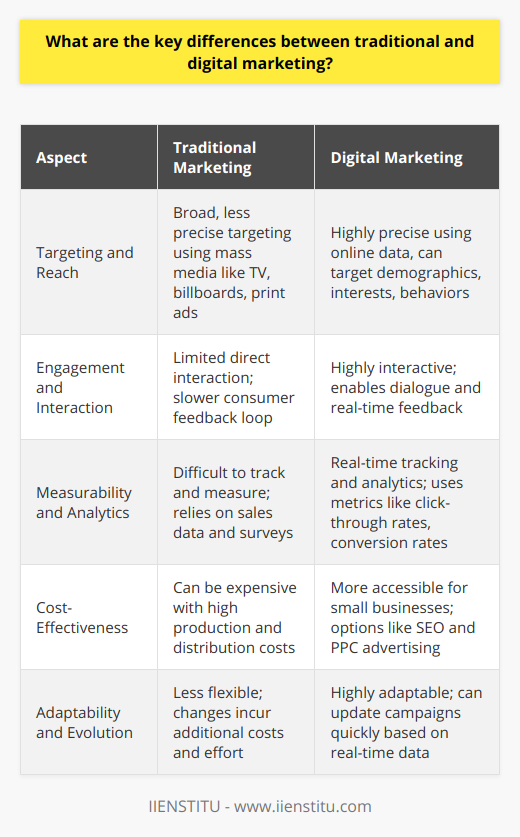
What are the advantages of digital marketing over traditional marketing?
Advantages of Digital Marketing
Cost-Effectiveness
One significant advantage of digital marketing over traditional marketing is its cost-effectiveness. Digital platforms enable businesses to reach a larger audience with minimal spending compared to print, television, and radio ads. This allows small and medium enterprises to compete with larger companies, leveling the playing field.
Targeted Audience Reach
Digital marketing enables businesses to reach specific target markets effectively by using data and analytics to track consumer behavior. This ensures that promotional content is shown to users who are more likely to engage with the brand, leading to improved conversion rates and increased sales.
Measurable Outcomes
Another advantage of digital marketing is the ability to monitor and analyze campaigns in real-time. This provides businesses with valuable insights into the effectiveness of their marketing efforts, allowing for quick adjustments and data-driven optimization. Traditional marketing approaches often lack this level of measurability and adaptability.
Global Reach
Digital marketing provides businesses with the opportunity to expand their reach globally. By leveraging platforms like social media and search engines, companies can interact with customers and prospects from around the world, enabling them to tap into new markets and increase the potential for growth.
Improved Engagement
Digital marketing facilitates two-way communication between businesses and consumers, fostering relationship-building and customer loyalty. This increased engagement can lead to improved customer satisfaction and loyalty, which benefits the company's reputation and long-term profitability. Traditional marketing methods are often one-sided, lacking this level of interaction.
Personalization and Customization
Digital marketing allows businesses to personalize and tailor content to individual users, providing a more relevant and engaging experience. This high level of customization leads to higher conversion rates and increased customer satisfaction. Traditional marketing techniques often rely on mass messages, which can be less effective for individual consumers.
In conclusion, digital marketing offers several advantages over traditional marketing by being more cost-effective, allowing for better targeting and personalization, and providing a measurable and global reach. Its versatile nature enables businesses to engage with consumers in ways that traditional marketing cannot, making it a valuable tool for companies seeking to expand and thrive in today's competitive market.
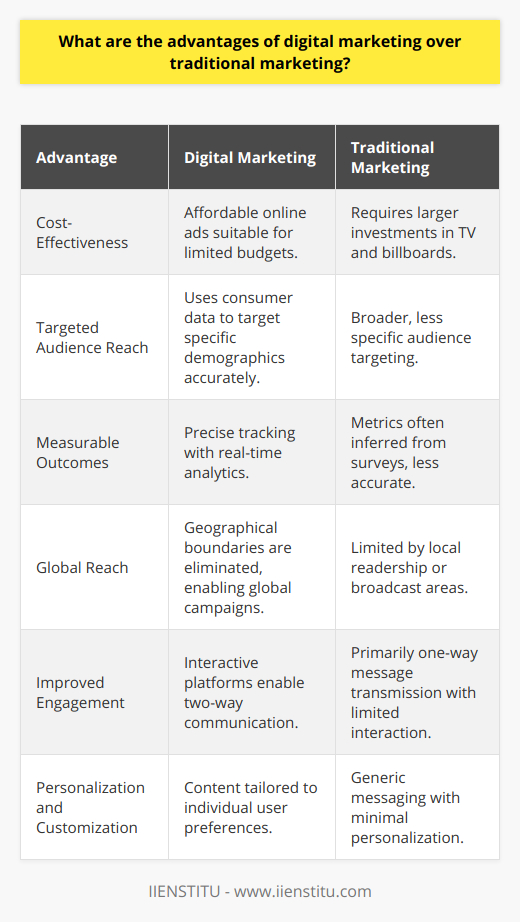
What is the key difference between traditional marketing and modern marketing?
Key Distinction Between Approaches
The fundamental difference between traditional marketing and modern marketing lies in the communication channels used and the level of customer engagement. Traditional marketing predominantly relies on one-way communication channels, such as print, radio, and television advertisements, where consumers passively receive information about a product or service. On the other hand, modern marketing places an emphasis on two-way communication channels and using the digital landscape to foster a dialogue with consumers.
Digital Presence and Interactivity
With the advent of digital platforms, modern marketing techniques, such as social media marketing, content marketing, and search engine optimization, enable businesses to interact more closely with their customers. Strategic emphasis is put on creating user-friendly websites, engaging content, and data-driven campaigns to attract, retain, and communicate with their target audience.
Data-driven Decision-making
Another significant distinction is that modern marketing heavily relies on data analytics and customer insights to make well-informed decisions. By gathering and analyzing customer behavior, preferences, and feedback, modern marketers can tailor their campaigns, products, and services to cater to the specific needs of their target audience. This helps businesses forge stronger, long-lasting relationships with customers and enhances brand loyalty.
Personalized Customer Experience
Finally, modern marketing prioritizes personalization as a powerful tool to create memorable customer experiences. By using data-driven customer profiles, businesses can offer customized and relevant content, deals, and promotions to suit individual preferences. This personalized approach further strengthens brand value and ensures customer satisfaction.
In conclusion, the primary difference between traditional and modern marketing lies in the way businesses engage with their customers. Modern marketing plays a significant role in leveraging digital platforms, using data-driven strategies, and providing personalized experiences, whereas traditional marketing mainly focuses on reaching customers through one-way communication channels. As a result, modern marketing has become a more effective and targeted approach in today's fast-paced digital era.
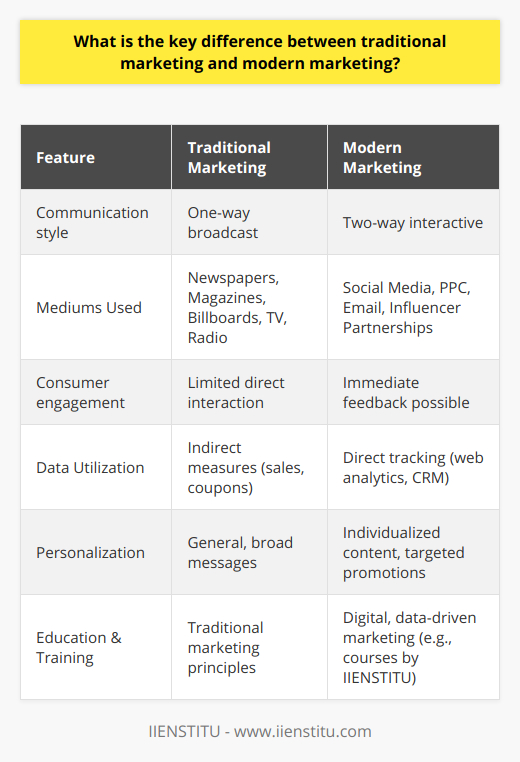
What are the two main differences between traditional marketing and social marketing?
Scope and Reach of Marketing Channels
The two main differences between traditional marketing and social marketing lie in the scope and reach of marketing channels and the role of customer engagement. Firstly, traditional marketing primarily relies on mass communication channels such as print, television, and radio to disseminate marketing messages (Kotler & Keller, 2016). These channels typically reach a broad audience, often with limited segmentation and targeting capabilities. On the other hand, social marketing utilizes digital channels such as social media platforms and email marketing. These channels not only reach a global audience but also enable businesses to identify and target specific customer segments with tailored messages (Tuten & Solomon, 2017).
Role of Customer Engagement
The second key difference between traditional and social marketing is their approach to customer engagement. In traditional marketing, brands communicate their messages to customers through a one-way communication process where feedback and engagement opportunities are limited (Kotler & Keller, 2016). This often results in a monologue where customers can only passively receive information from the brand. Conversely, social marketing encourages two-way communication between the brand and the customer (Hanna, Rohm, & Crittenden, 2011). Through platforms such as Facebook and Twitter, customers can easily interact with brands, share their opinions and experiences, and co-create content. This increased level of engagement fosters a stronger relationship between the customer and the brand, which may eventually lead to improved customer loyalty and advocacy (Tuten & Solomon, 2017).
In conclusion, social marketing has transformed the way businesses communicate and engage with their customers. The shift from traditional marketing channels to digital platforms enables marketers to reach targeted audiences more effectively and foster meaningful interactions. This not only enhances brand reputation and loyalty but also yields valuable insights into customer preferences and behaviors, which can inform future marketing strategies.

What makes digital marketing different from traditional marketing methods?
Distinct Characteristics of Digital Marketing
The fundamental difference between digital and traditional marketing lies in the medium through which they reach and engage potential consumers. While traditional marketing methods involve print, television, and radio advertisements, digital marketing utilizes digital channels such as social media, blogging, and email marketing to target and interact with a specific audience. Consequently, this distinction leads to various unique aspects of digital marketing that set it apart from traditional marketing.
Flexibility and Personalization
Digital marketing allows businesses to tailor their messages to a specific audience with personalized content, unlike standardized traditional marketing campaigns. By leveraging segmentation and analytic tools, marketers can develop responsive and customized strategies that directly address the diverse needs, preferences, and behaviors of their target audience. This dynamic nature enhances the possibility of driving traffic and increasing conversion rates, as well as building long-term relationships with consumers through personalized communication.
Measurable Metrics and Analytics
One notable advantage of digital marketing over traditional marketing is the availability of accurate, real-time data and analytics. Digital marketers can directly measure campaign efficiency, audience engagement, and return on investment (ROI). Through these key performance indicators (KPIs) and other online analytics, marketers can evaluate and adjust their strategies, making more data-driven decisions to optimize results. In contrast, traditional marketing often relies on indirect assessment methods and incomplete data, making it difficult to accurately evaluate outcomes or adjust campaigns in real time.
Cost Efficiency and Reach
Digital marketing provides an economical alternative to traditional marketing, as it often requires a lower budget and can achieve a broader reach. Startups and small businesses benefit from this cost efficiency as it allows them to compete with larger corporations. In addition, digital marketing enables marketers to reach out to global audiences, unlike traditional marketing, which is primarily limited to local or regional target markets. This global reach helps businesses scale and expand more easily, reaching potential customers beyond geographic boundaries.
Engagement and Interactivity
Digital marketing facilitates two-way communication and interactivity, encouraging consumer engagement and fostering strong relationships. Content sharing, comment sections, and social media networks enable businesses to gather direct feedback and insight from their audience, which can be invaluable for improving products and services. In contrast, traditional marketing is mostly one-sided, allowing limited interaction and engagement opportunities.
In conclusion, digital marketing differentiates itself from traditional marketing methods through its flexibility, personalization, measurable metrics, cost efficiency, and interactivity. Its ability to adapt to a rapidly evolving marketplace and capitalize on emerging technologies has made digital marketing an essential component of modern business strategies.
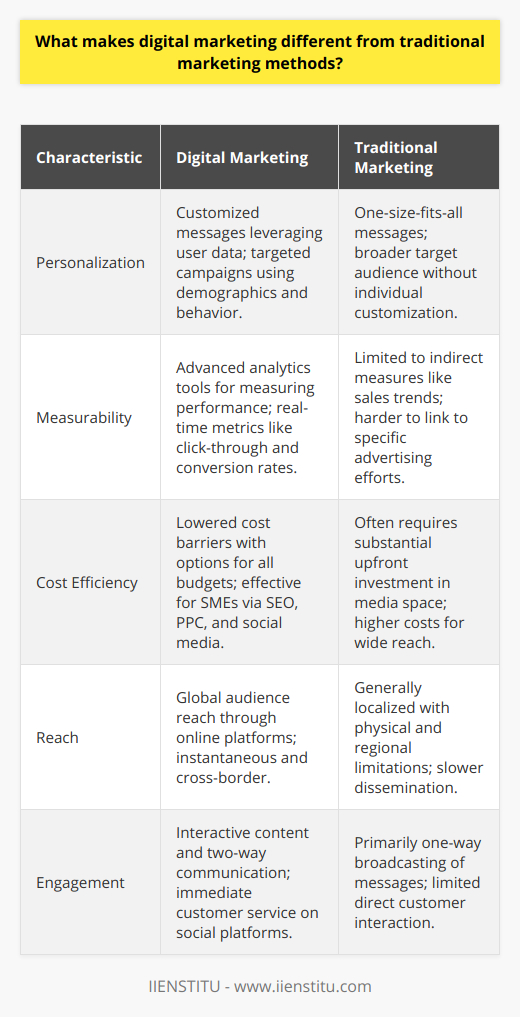
How does the integration of digital channels impact the overall marketing strategy?
Digital Channels and Marketing Strategy
Introduction
The integration of digital channels significantly impacts the overall marketing strategy as it presents organizations with innovative methods to expand their customer reach, improve the efficiency of their marketing endeavours, and analyze data for better decision-making. Digital channels play a critical role in adopting a customer-centric approach that delivers value to prospects and clients alike.
Customer Reach
Incorporating digital channels into the marketing strategy allows companies to access a global audience through various platforms such as social media, email marketing, and search engine optimization. These tools provide an opportunity to target prospects more precisely, leading to a higher conversion rate. Furthermore, digital channels enable businesses to interact with consumers in real-time, creating an engaging and personalized experience.
Efficient Marketing Approaches
Utilizing digital channels not only streamlines the overall marketing process but also lowers related expenses. Transitioning from traditional marketing approaches, such as print advertising and billboards, to more cost-effective digital alternatives, allows businesses to allocate their marketing budget more efficiently. Additionally, digital channels provide the ability to track and measure campaign performance with ease, enabling marketers to optimize strategies accordingly.
Data-driven Decision-making
Digital channels also provide valuable insights that fuel data-driven decision-making. With access to granular information about user behaviour and preferences, marketers can uncover patterns and trends that inform campaign refinements. By continually analyzing and adjusting based on real-time data, organizations are better positioned to remain agile and competitive in an ever-evolving marketplace.
Conclusion
In conclusion, the integration of digital channels plays a pivotal role in shaping the overall marketing strategy. Digital channels expand customer reach, facilitate efficient marketing approaches, and support data-driven decision-making. Embracing the digital shift is no longer an option but a necessity for organizations looking to thrive in today's business landscape.

In what ways does the rapid evolution of digital technology influence marketing trends and practices?
Impact on Consumer Behavior
The rapid evolution of digital technology has a profound impact on marketing trends and practices by transforming consumer behavior. With increased internet accessibility, consumers now have the ability to research products and services, compare prices, and read reviews before making a purchase decision. This shift in power from marketers to consumers has led to a more informed and demanding audience, requiring businesses to adjust their marketing strategies and focus on delivering value while fostering trust.
Data-driven Decision Making
Digital advancements have also enabled businesses to gather more information about their customers, allowing for more efficient and targeted marketing campaigns. Data analytics tools have made it possible to track customer preferences and behaviors, leading to the development of more personalized and relevant marketing content. In turn, this has helped improve customer satisfaction, loyalty, and lifetime value by providing tailored experiences that resonate with individual preferences.
Greater Emphasis on Social Media
Another significant influence of digital technology on marketing trends and practices lies in the growing importance of social media platforms. Businesses are leveraging the power of social media to build brand awareness, engage with their audiences, and generate leads. These platforms offer a cost-effective way to reach a vast audience and encourage dialogue, allowing businesses to better understand their customers and refine their marketing messages. Furthermore, social media marketing enables businesses to harness the potential of user-generated content and influencers to boost their brand image and authenticity.
Rise of Mobile Marketing
Mobile technology has also revolutionized marketing practices by offering new and innovative ways to reach and engage consumers. The increased usage of smartphones and tablets has opened up numerous possibilities for mobile marketing, from location-based targeting to in-app advertising and mobile-first website designs. As a result, businesses are investing heavily in mobile marketing strategies and recognizing the need for seamless, responsive experiences to cater to users who expect fast, convenient, and enjoyable interactions.
Increased Use of Video Content
Lastly, the rapid evolution of digital technology has also contributed to the increased popularity of video content in marketing strategies. As internet speeds improve and video platforms continue to expand, the use of video content for marketing purposes is rapidly growing. This trend has led to new ways of storytelling that engage consumers, such as live streaming, virtual and augmented reality experiences, and interactive videos. These immersive formats hold great potential for increasing audience engagement and driving sales.
In conclusion, the rapid progression of digital technology has shaped marketing trends and practices by revolutionizing consumer behavior, facilitating data-driven decision making, emphasizing social media, embracing mobile marketing, and promoting the use of video content. As these and other digital advancements continue to emerge and evolve, businesses must remain agile and adapt to capitalize on the opportunities they present.
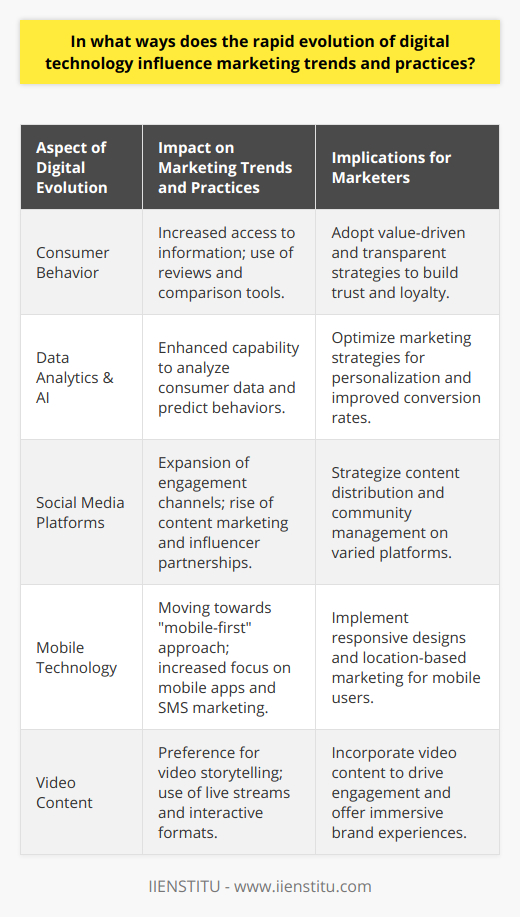
What is the difference between traditional marketing and modern marketing when considering customer engagement?
Traditional vs Modern Marketing: A Focus on Customer Engagement
Traditional marketing revolves around reaching a wide audience. The marketer relies heavily on numbers, essentially playing a quantity game in order to attain customer engagement. Advertisements on TV, print media, and radio exemplify this strategy. Consequently, this approach often lacks personalisation. It's frequently one-sided, with little to no interaction between the business and the potential customer.
Contrastingly, modern marketing, particularly digital marketing, strives for targeted customer engagement. It employs web analytics, SEO, email automation, and social media marketing, aiming for an individualised approach. This strategy focuses on creating two-way conversations with consumers, fostering deeper relationships. Resultantly, businesses can better understand their customers' wants, needs, and buying behaviours, aiding in tailoring products or services that meet consumer expectations.
Different Platform Usage
Traditional marketing primarily depends on offline platforms. Meanwhile, modern marketing leverages multiple online channels. The shift to digital platforms allows modern marketers to be more accessible. Consumers can engage at their convenience, further fostering interaction and dialogue. This immediate, constant accessibility creates a meaningful engagement, improving customer satisfaction and loyalty.
Approach to Data
Traditional marketing broadly targets demographics without significant data analysis. On the other hand, modern marketing capitalises on data-driven decisions. Through data analytics, companies can comprehend the customer journey better. They can adapt to customer behaviours and preferences in real-time. Therefore, modern marketing facilitates a more refined, data-informed engagement strategy.
In conclusion, customer engagement differentiates traditional from modern marketing. Traditional marketing is a monologue, seeking to reach many with a predetermined message. In comparison, modern marketing facilitates a dialogue, striving for targeted, data-backed, meaningful interactions.
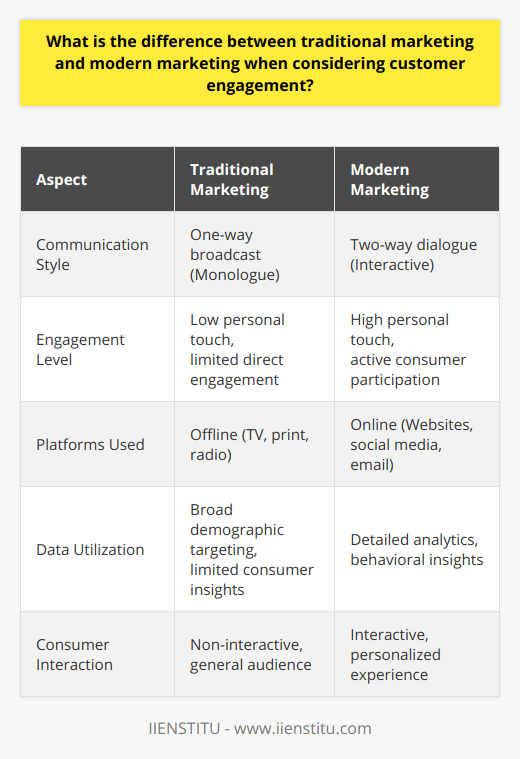
How do the effectiveness and measurability of traditional marketing campaigns compare to those of modern digital marketing strategies?
Comparative Analysis of Traditional and Digital Marketing Strategies
Traditional marketing remains effective in reaching a local, targeted demographic. This approach holds considerable value and success in terms of brand exposure. However, its ability to convey complex data sets for marketing strategy adjustment is limited. Further, measuring return on investment (ROI) commonly poses difficulties due to limited quantifiable datasets.
Attractiveness of Digital Strategies
Digital marketing strategies boast higher effectiveness and measurability. Platforms such as social media, search engines, and email provide a global reach, often at a lower cost. Interactive digital content attracts diverse audiences and engages them more effectively. A study by Van Dijck (2013) shows a higher consumer response rate in digital campaigns compared to traditional ones.
Performance Metrics in Digital Marketing
The revolutionary advantage of digital marketing is its measurable nature. Google Analytics, for instance, provides granular insights about a campaign’s performance in real-time. Tracking indicators like website traffic, bounce rate, conversion rate, and social media engagement become possible. Hence, marketers can swiftly tweak their strategies based on the results.
ROI Evaluation in Digital Marketing
Furthermore, digital marketing facilitates an accurate ROI evaluation. It does so via specific sales funnel tracking and direct response data. Making strategic planning and budget allocation decisions then becomes effortless. As per a Gartner's 2020 report, businesses that used data-driven marketing saw up to 20% increase in their ROI.
Nevertheless, the choice between traditional and digital marketing depends on the business size, target audience, and budget. However, given the efficiency, scalability, and measurability of digital strategies, it’s safe to say they dominate the marketing narrative today.

In terms of global reach and market accessibility, how do traditional marketing methods differ from online marketing techniques?
Geographical Reach
Traditional marketing methods and online marketing techniques present considerable differences regarding global reach. In essence, traditional marketing such as print, television, and radio advertisements are geographically bound. In other words, they target a specific geographical area or demographic group according to the nature of the medium used.
Market Accessibility
Conversely, online marketing transcends geographical limitations. By leveraging the internet, online ads reach any location with internet access, maximizing market accessibility. Social media platforms, search engines, and websites serve as virtual channels, fostering a global exchange between businesses and consumers.
Cost-Efficiency
Another key contrast lies in cost-efficiency, with online marketing being more economical and flexible than traditional methods. Online advertising often charges based on engagement, ensuring businesses only pay for actual results. Additionally, online platforms offer real-time data analysis, guiding businesses to adapt their strategies based on ongoing trends and consumer behavior.
Dynamic Engagement
Online marketing also paves the way for dynamic, interactive engagement with consumers. It enables real-time communication and feedback, allowing businesses to address concerns, answer queries, and build healthier relationships with customers. In contrast, traditional modes offer limited interaction, primarily functioning on a one-way communication model.
Conclusion
To sum up, traditional marketing and online marketing greatly differ in global reach and market accessibility. While traditional methods are localized and less interactive, online techniques capitalize on the global reach of the internet, resulting in efficient cost management and dynamic engagement with consumers.


